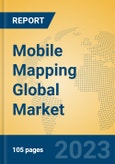Market Size and Growth Forecast
The global mobile mapping market is projected to reach between USD 25 billion and USD 30 billion in 2025, with a compound annual growth rate (CAGR) of 11% to 17% through 2030, reflecting the increasing demand for geospatial solutions and technological advancements.Regional Analysis
- North America: The U.S. leads with widespread adoption in autonomous vehicles and smart cities. Canada focuses on environmental and infrastructure mapping.
- Europe: Germany, France, and the UK dominate, driven by urban planning and telecommunication needs. The region emphasizes sustainable mapping solutions.
- Asia Pacific: China and India see rapid growth due to smart city projects and agriculture. Japan prioritizes precision mapping for disaster management.
- Rest of the World: Brazil leverages mobile mapping for agriculture, while the UAE invests in smart infrastructure.
Application Analysis
- Agriculture: Expected growth of 12-18%, driven by precision farming. Trends focus on AI-driven analytics.
- Oil & Gas: Projected growth of 11-16%, fueled by pipeline monitoring. Developments emphasize real-time data.
- Government & Public Sector: Anticipated growth of 12-17%, tied to urban planning. Advances highlight disaster response mapping.
- Telecommunication: Expected growth of 11-16%, driven by 5G infrastructure planning. Trends focus on network optimization.
- Energy & Utilities: Projected growth of 10-15%, linked to asset management. Developments prioritize cloud-based solutions.
- Others: Anticipated growth of 9-14%, including transportation, with trends in autonomous vehicle mapping.
By Component Analysis
- Hardware: Expected growth of 11-17%, driven by demand for LiDAR and GNSS systems. Trends highlight compact, high-precision sensors.
- Software: Projected growth of 12-18%, fueled by AI and cloud-based platforms. Advances emphasize real-time processing.
- Services: Anticipated growth of 10-15%, tied to consulting and integration. Developments focus on customized mapping solutions.
Key Market Players
Leading firms include Trimble, Alphabet, Hexagon, TOPCON CORPORATION, Teledyne Geospatial, imajing SAS, RIEGL, Hi-Target, GreenValley International, and Klau Geomatics, driving innovation in geospatial technologies.Porter's Five Forces Analysis
- Threat of New Entrants: Moderate, due to high technology costs but opportunities for software-based solutions.
- Threat of Substitutes: Low, as mobile mapping offers unique geospatial accuracy.
- Bargaining Power of Buyers: Moderate, with demand for cost-effective, scalable systems.
- Bargaining Power of Suppliers: Moderate, due to specialized sensor and software providers.
- Competitive Rivalry: High, with firms competing on accuracy, scalability, and integration.
Market Opportunities and Challenges
Opportunities: The rise of autonomous vehicles, with over 10 million units projected by 2030, drives demand. Smart city projects, covering 50% of global urban areas, fuel growth. Innovations like Hexagon’s AI-driven mapping platforms enhance efficiency. Emerging markets offer untapped potential.Challenges: High hardware costs limit adoption for smaller firms. Data privacy and regulatory compliance pose hurdles. Integration with existing GIS systems and skill shortages remain barriers.
This product will be delivered within 1-3 business days.
Table of Contents
Companies Mentioned
- Trimble
- Alphabet
- Hexagon
- TOPCON CORPORATION
- Teledyne Geospatial
- imajing SAS
- RIEGL Laser Measurement Systems GmbH
- Hi-Target
- GreenValley International
- Klau Geomatics








